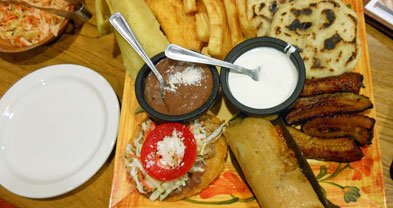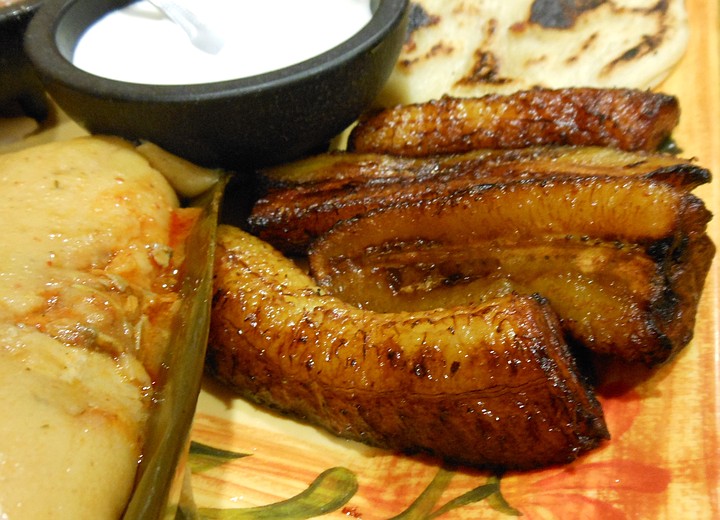 Facebook
Facebook
 X
X
 Instagram
Instagram
 TikTok
TikTok
 Youtube
Youtube

It was a dark and rainstormy night. Marvel as our hero tramps undaunted through the dripping streets of Grant Hill. Crosses 26th, 27th, 28th, ever searching for his Shangri-La.
Aha! Suddenly, lights! Camera! ¡Acción! A sign on a rain-spattered wall!
“Restaurante El Salvadoreño.”
Yes, it’s painted on a wall behind a chain-link fence protecting an empty lot, but the front’s a fresh-painted olive green, with white-framed windows behind black grilles.
Was down El Salvador way once, long ago. Chowed down at pupuserias and drank Kolashampan, that sweet golden soda that tastes like real bubbly, even though there’s no alcohol.
There’s something about gentle fare from a land that’s gone through so much — like that horrific civil war back in the ’80s — that draws you to it. Talk about comfort food...
Pupusas? Beautiful word they say comes from the Pibil people, who live down there, and always have.
So in I go, hungry as a horse in a hay barn. The large room is divided into two sections, and even now, at 8:00 p.m., it’s abuzz. Not packed, but no way empty.
It’s all varnished timber and goldy-brown paint. Green columns with painted ropes. A Bible on the welcome desk sits open, the text highlighted in yellow. A wooden plaque hung over the kitchen has been chiseled to say: “Welcome, Bienvenidos!”
Palm-leaf fans whir slowly overhead. There are blond solid-wood chairs decorated with dark green struts — almost feels Western — and big black-and-white photos of (says the waiter Francisco) the San Salvadoran presidential palace.

Francisco seats me near a group of mainly gringos all chowing down from big sampler plates. Plantains, tamales, enchiladas, fried yucca sticks, everything arranged around bowls of frijoles and sour cream. Dang, it looks good. Luis, who says he’s the lone salvadoreño in the group, claims this is the best pupusa place in town.
I ask for Kolashampan, and Francisco leaves a menu. Man, there’s a lot. From all-day breakfast to dozens of dishes. You can pay about as little or as much as you want. Like, there’s a breakfast of fried yucca with ground pork for $9.50. Or you can go for the pupusas at $2 each. Two would probably be enough. They have all sorts, but the most popular, Francisco says, is the one stuffed with chicharrón and cheese. Seems chicharrón for Salvadorans means ground pork mashed almost to a paste.
The one I want is the pupusa loroco.
That’s the traditional thick tortilla stuffed with the loroco flower or quilite (“edible herb”). Grows only in Central America. And, hey, apart from tasting pretty, well, herby, it’s supposed to be an aphrodisiac.
They also have tamales with pork or maize (Indian corn) stuffed inside. Or chicken enchiladas (three for $7.50), or a whole batch of yucca (cassava root) chips, like large french fries, but much tastier, for $4.50.

And here’s Francisco with…oh, this drink’s called Goya Cola Champagne. Really does taste champagne-y.
Decision time. Have to say that the sampler plate looks delicious. But $17.99? Then I think: the beautiful Carla will be waiting, starving, hoping, back at the ranch, and that would make it only $9 each, right? And for sure we’re talking extras for another day. So, what the heck. I order it.
Deliciously good decision, even though I’ll be out a Jackson.
The plate arrives loaded and hot, with a wooden side bowl of curtido. Lot of folk have come to places like this thinking curtido was cole slaw, then complained that it was limp and old and vinegary. Me, too. But turns out, that’s what it’s supposed to be. Pickled (fermented) cabbage, with onion and carrot topping, designed to add tang to your tongue. Like sauerkraut, or kimchi.
Where to start? When in El Salvador…pupusa has got to be the opener. Just sprinkle some salt and it’s a cushiony little flying saucer, toasty on the outside, moist and porky sabroso inside. Pupusa is the litmus test for any Salvadoran meal, along with the universal aftertaste of corn.
The pork tamal feels like it’s got both the chicharrón mixed with maize and extra pork meat. It’s almost liquidy around the meat chunks. The chicken enchilada has more of a fried crispiness. Love it, though I’m gonna have to run for a few buses to sweat all this off. The cornbread-tasting tamal has to have been just-steamed.
“Maria Constanta brought every recipe from El Salvador,” says Francisco. “She’s the lady who started this restaurant in 1995. She and her family still run it.”
He says the farther south you go, the less picante the food is. “But I like it,” he says. “And I’m Mexican.”
Although, now that I take another forkful, this curtido is plenty picante .
The desserts are custardy, or else rice-pudding types. But I’m full. Plus, the glistening plantains that came with the sampler were beautifully sweet.
I pay. Then, on a thought, count what I’ve got left. Yes! Just enough.
“Could you make me a pupusa loroco to go?”
You never know, maybe it does deliver on its aphrodisiacal promise.
Francisco says, head down, staring into his order book, “Good choice, señor.” ■


It was a dark and rainstormy night. Marvel as our hero tramps undaunted through the dripping streets of Grant Hill. Crosses 26th, 27th, 28th, ever searching for his Shangri-La.
Aha! Suddenly, lights! Camera! ¡Acción! A sign on a rain-spattered wall!
“Restaurante El Salvadoreño.”
Yes, it’s painted on a wall behind a chain-link fence protecting an empty lot, but the front’s a fresh-painted olive green, with white-framed windows behind black grilles.
Was down El Salvador way once, long ago. Chowed down at pupuserias and drank Kolashampan, that sweet golden soda that tastes like real bubbly, even though there’s no alcohol.
There’s something about gentle fare from a land that’s gone through so much — like that horrific civil war back in the ’80s — that draws you to it. Talk about comfort food...
Pupusas? Beautiful word they say comes from the Pibil people, who live down there, and always have.
So in I go, hungry as a horse in a hay barn. The large room is divided into two sections, and even now, at 8:00 p.m., it’s abuzz. Not packed, but no way empty.
It’s all varnished timber and goldy-brown paint. Green columns with painted ropes. A Bible on the welcome desk sits open, the text highlighted in yellow. A wooden plaque hung over the kitchen has been chiseled to say: “Welcome, Bienvenidos!”
Palm-leaf fans whir slowly overhead. There are blond solid-wood chairs decorated with dark green struts — almost feels Western — and big black-and-white photos of (says the waiter Francisco) the San Salvadoran presidential palace.

Francisco seats me near a group of mainly gringos all chowing down from big sampler plates. Plantains, tamales, enchiladas, fried yucca sticks, everything arranged around bowls of frijoles and sour cream. Dang, it looks good. Luis, who says he’s the lone salvadoreño in the group, claims this is the best pupusa place in town.
I ask for Kolashampan, and Francisco leaves a menu. Man, there’s a lot. From all-day breakfast to dozens of dishes. You can pay about as little or as much as you want. Like, there’s a breakfast of fried yucca with ground pork for $9.50. Or you can go for the pupusas at $2 each. Two would probably be enough. They have all sorts, but the most popular, Francisco says, is the one stuffed with chicharrón and cheese. Seems chicharrón for Salvadorans means ground pork mashed almost to a paste.
The one I want is the pupusa loroco.
That’s the traditional thick tortilla stuffed with the loroco flower or quilite (“edible herb”). Grows only in Central America. And, hey, apart from tasting pretty, well, herby, it’s supposed to be an aphrodisiac.
They also have tamales with pork or maize (Indian corn) stuffed inside. Or chicken enchiladas (three for $7.50), or a whole batch of yucca (cassava root) chips, like large french fries, but much tastier, for $4.50.

And here’s Francisco with…oh, this drink’s called Goya Cola Champagne. Really does taste champagne-y.
Decision time. Have to say that the sampler plate looks delicious. But $17.99? Then I think: the beautiful Carla will be waiting, starving, hoping, back at the ranch, and that would make it only $9 each, right? And for sure we’re talking extras for another day. So, what the heck. I order it.
Deliciously good decision, even though I’ll be out a Jackson.
The plate arrives loaded and hot, with a wooden side bowl of curtido. Lot of folk have come to places like this thinking curtido was cole slaw, then complained that it was limp and old and vinegary. Me, too. But turns out, that’s what it’s supposed to be. Pickled (fermented) cabbage, with onion and carrot topping, designed to add tang to your tongue. Like sauerkraut, or kimchi.
Where to start? When in El Salvador…pupusa has got to be the opener. Just sprinkle some salt and it’s a cushiony little flying saucer, toasty on the outside, moist and porky sabroso inside. Pupusa is the litmus test for any Salvadoran meal, along with the universal aftertaste of corn.
The pork tamal feels like it’s got both the chicharrón mixed with maize and extra pork meat. It’s almost liquidy around the meat chunks. The chicken enchilada has more of a fried crispiness. Love it, though I’m gonna have to run for a few buses to sweat all this off. The cornbread-tasting tamal has to have been just-steamed.
“Maria Constanta brought every recipe from El Salvador,” says Francisco. “She’s the lady who started this restaurant in 1995. She and her family still run it.”
He says the farther south you go, the less picante the food is. “But I like it,” he says. “And I’m Mexican.”
Although, now that I take another forkful, this curtido is plenty picante .
The desserts are custardy, or else rice-pudding types. But I’m full. Plus, the glistening plantains that came with the sampler were beautifully sweet.
I pay. Then, on a thought, count what I’ve got left. Yes! Just enough.
“Could you make me a pupusa loroco to go?”
You never know, maybe it does deliver on its aphrodisiacal promise.
Francisco says, head down, staring into his order book, “Good choice, señor.” ■